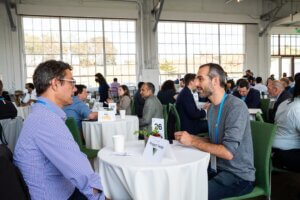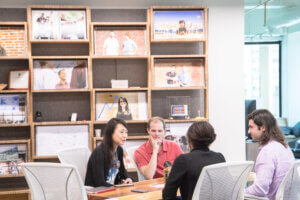
Funding Opportunities
Why Elemental
At Elemental, we provide funding and in-depth support to promising climate technology startups with social impact potential. Over the past 14 years, Elemental has invested in more than 150 portfolio companies and built a vibrant community of entrepreneurs with world-changing solutions.
Strategy Track
$350K
of funding and coaching to help your company strengthen its core growth strategy, including market intelligence, sales and growth, operational scale-up, equity and access, messaging, fundraising and policy
Project Track
$1M – $3M
of funding and tailored support, including expert coaching, to deploy a transformational commercial project in any global market (a majority of projects will be funded in the U.S.)
We invest across 7 interconnected systems
Program Fit
At a minimum, we require all applicants, regardless of track, to:
- Be a startup addressing climate change and related issues
- Be a for-profit, stand-alone venture
- Have at least two full-time employees
- Have at least an operating prototype
We require Project Track applicants to:
- Have at least one initial pilot deployment in progress or completed
Your company will get the most out of Elemental if you:
- Are Pre-Seed – Series D+ stage
- Have demonstrated product-market fit and customer traction
- Are looking to do something transformational for your business, such as expand your product, customer base, equity outcomes and/or geographic reach or to fund the development costs for an infrastructure project
- Are building solutions that create good quality, local jobs for people who live in frontline communities and are committed to justice, equity, diversity and inclusion
- Have an engaged CEO with a diverse executive team that wants to be an active part of a global ecosystem of change-makers
Who we do not fund
- Project developers (solar, wind, storage, etc.) selling third party products
- Consulting firms
- Marketing or PR agencies
- Nonprofits
- Acquired startups
Application Process and Timeline
Applications open
April 10
Applications for all tracks are open and will be reviewed as they come in. We encourage you to submit your application as soon as possible.
Elemental Live: What It Means to be an Elemental Portfolio Company
April 24, 2024 | 10:00 a.m. PT | Virtual
Join us for our first Elemental Live of the year, with special guest hosts from our portfolio of climate tech entrepreneurs. We’ll share more about how we work with companies, and answer any questions you may have.
RegisterElemental Live: Maximizing Deals in Rocky Markets
April 30, 2024 | 10:00 a.m. PT | Virtual
Join Elemental's Investor in Residence, Avra Durack, for an insider perspective on how companies can find ways to raise capital during turbulent markets.
RegisterElemental Live: Designing a Project for Deep Community Impact
May 13, 2024 | 10:00 a.m. PT | Virtual
Join Elemental’s Equity and Access team to learn practical tools and strategies for embedding equity into your climate tech deployment.
RegisterElemental Live: Shovels in the Ground, Securing Project Finance
May 23, 2024 | 10:00 a.m. PT | Virtual
Hosted by Elemental’s Financier in Residence, Natalie Volpe, we’ll provide guidance on securing project financing, including real-life example deals from our portfolio and beyond.
RegisterApplications close
May 31, 2024
This is the final deadline to submit an application for Cohort 13.
Submit additional materials
June – July 2024
Select applicants will be invited to share more about their technology, business and strategy for scaling impact. We will also spend time getting to know their customers, investors and community partners.
Interviews & reference calls
July – August 2024
Select applicants will be invited to interview with Elemental to better understand their company. As we progress through the due diligence process, we will spend time getting to know customers, investors, and community partners that you have previously worked with.
Final selection
September 2024
Cohort offers will be made all at once. Following program acceptance, companies will become acquainted with Elemental’s team, systems and services.
Cohort Kickoff and CEO & Leadership Summit
February 2025
Cohort 13 companies will spend time in person getting to know the Elemental team, fellow cohort members and our partners through workshops and facilitated discussions. Then, we'll be joined by other alumni CEOs and leaders from the Elemental portfolio to share knowledge and connect.
Resources
Have more questions? Download the Cohort 13 Application Packet to learn more about the program.
FAQs
How does Elemental define low-income and disadvantaged communities (LIDAC) and frontline communities?
At Elemental, we prioritize equitable projects in low-income and disadvantaged communities (LIDAC) and frontline communities.
United States
For projects in the U.S., we use the Environmental Protection Agency’s (EPA) Greenhouse Gas Reduction Fund definition of low-income and disadvantaged communities. LIDACs, as defined by the EPA, meet one or more of the following four categories: (1) communities identified as disadvantaged by the CEJST mapping tool; (2) a limited number of additional communities identified as disadvantaged by the EJScreen mapping tool; (3) geographically dispersed low-income households; and (4) properties providing affordable housing.
Global
We expect companies working or looking to work in countries outside of the U.S. to adapt
Elemental’s frameworks for approaching projects and to research, explore, and seek out local feedback on the appropriate definitions and tools for the geography they aim to deploy in. Generally speaking, we define frontline communities as those striving to become more resilient to the near-term and immediate climate threats they face and who have been systematically overburdened and underserved. These communities face unjust exposure to the impacts of climate change due to a legacy of systemic, largely racialized, inequity that influences their living and working places, their quality of air and water, and their economic opportunities. Frontline communities often include people of color, immigrants, people with lower incomes, those in rural areas, and Indigenous people.
How does Elemental evaluate and select their portfolio companies?
At a high level, regardless of track, we consider many factors when evaluating and selecting companies:
- Impact: Does the company and solution have a positive environmental, social, and community impact?
- Solution & technology: Does the solution uniquely solve a major problem and is the technology differentiated from competitors? Can the solution scale?
- Business model & financials: Does the company have a compelling business model and healthy financials that can support the company in the near term?
- Team: Can the team contribute value to the company through expertise or unique lived experiences? Has the team been designed with justice, diversity, equity, and inclusion in mind? Is the leadership team made up of traditionally excluded individuals?
- Program fit: Will our engagement together be transformational for the business and is the track aligned with the company’s strategy?
Is relocation and/or travel required to participate in the program?
Elemental funds companies from all over the world and relocation is not required to participate in our program. We do come together in person throughout the year for our annual Program Elements, including Cohort Kickoff, CEO & Leadership Summit, and Elemental Interactive. All Cohort CEOs and another C-suite member will be required to participate in all elements for the first year of the program. We ask that companies participate in one or two of the elements in the following years to continue building relationships among companies and partners, share their learnings, and seek new opportunities within our ecosystem.
What is the time commitment for each track?
For Strategy Track companies, the core program runs October 2024 through August 2025. Companies can anticipate two to five hours per week of workshops, 1:1 coaching, and applied strategy work for the CEO and one additional team member per module.
For Project Track companies, the time commitment varies based on the status and management requirements of each project. Elemental’s roster of coaches are available to accelerate a company’s project objectives and company goals. Elemental pairs companies with coaches they believe will meet the company’s current needs, and companies work with the coaches to build out their work plans and desired outcomes in more detail. Hours vary based on need and scope.
For all tracks, the company participates in regular (typically monthly) check-in calls with
Elemental’s Innovation team to share updates on the engagement and identify any opportunities for support. Members of the leadership team are expected to join the events noted above and complete the full Equity In curriculum, including workshops, group, and one-on-one coaching.
What is Elemental’s stance on paying community-based partners for their work?
Many times, local community organizations are asked to volunteer their time without expectation of compensation. This well-accepted norm has led to an underinvestment in community-based organizations on valuable work. We believe that, similar to how a company would procure and hire a project consultant, fair compensation for community partners is the appropriate way to acknowledge the significant contributions they make to a project’s success. Watch our Founder & CEO Dawn Lippert’s TED Talk to learn more about our model.
How does Elemental decide how much funding to award Project Track applicants?
Project Track applicants are eligible to receive between $1M – $3M USD. Each Project Track applicant is evaluated on a variety of factors, including project funding requirements, GHG reduction potential, community impact, and more. The size of funding awarded will be evaluated on a project-by-project basis. Companies that pass the first round of diligence will be invited to present additional material for the team to determine funding award amounts.
Can you provide more information on the funding instruments you use?
As a nonprofit organization, any proceeds from our investments go to supporting future climate technology entrepreneurs. For project and strategy track companies, we use either a Simple Agreement for Future Equity (SAFE), convertible note, or in some cases may be able to participate directly in an open round. We are also actively piloting new funding instruments.
Simple Agreement for Future Equity (SAFE):
Y Combinator created the SAFE as a simpler alternative to convertible notes. It allows investors to purchase shares in a future round at a pre-negotiated discount (industry standard is 20%). We like this investment vehicle because it is founder-friendly and flexible, allowing us to work with companies outside of their usual fundraising cycles. Accepted companies will execute three separate SAFEs with Elemental, each aligned with program milestone deliverables and payment amounts.
Convertible Note:
In some cases, we will use a convertible note. This flexibility allows later-stage companies to choose the right instrument for their needs. We can share more information about the commercial terms of our convertible note at an appropriate time in the application process. Accepted companies will execute multiple notes with Elemental, each aligned with program milestone deliverables and payment amounts.
Direct Investments:
In some instances, Elemental will directly participate in an open round if the timing aligns with completion of the milestones deliverables. In addition, as Elemental is constantly looking to fill financial and programmatic gaps, we may offer other funding mechanisms in the future. We will work closely with accepted companies to find a path that makes sense for both parties.
Can a company apply to multiple tracks? Or switch which track they’re applying to during the application process?
We ask companies to identify the single best track based on their needs. In the application, companies interested in applying for the Project Track will be asked to submit additional details. In some cases after application submission, we may advise switching to a better-fitting track depending on the company stage and goals.
How many companies will you accept into the cohort? How many companies will be in each track?
We will select and fund 15-20 companies across the two tracks. We do not have a set target for the total number of companies in each.
Who participates in the Strategy Track programming? Can single founders apply?
Companies must have at least two full-time employees to participate in our program. We ask that the company CEO and a second dedicated team member be involved in the module programming throughout the entire engagement. We are happy to have additional team members participate as is relevant to their role and interest.
For the Project Track, can I apply with a project that is already in progress?
We want our funding to go toward something that will be net new for the company. Often, companies apply for our funding to unlock something new for the business or accelerate the launch of something like a new product offering, a new business model, a new customer segment, and/or a geographic expansion. In other cases, our Project Track funding is used for something critical and additive to an ongoing project, such as funding development costs for permitting, engineering, or community engagement. Successful applicants will be able to articulate the additionality of Elemental funding.







